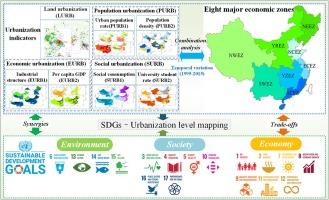多维城市化对可持续发展目标(SDGs)的影响:对中国 31 个省份的长期分析
IF 7
2区 环境科学与生态学
Q1 ENVIRONMENTAL SCIENCES
引用次数: 0
摘要
可持续发展与全球人类的生存息息相关,已引起人们的极大关注。城市化的快速发展对联合国可持续发展目标(SDGs)的实现和进展产生了深远的影响。然而,在城市化对这些目标的全面影响方面仍然存在知识空白。本研究通过全面分析四个不同的城市化维度:土地城市化(LURB)、经济城市化(EURB)、人口城市化(PURB)和社会城市化(SURB),深入探讨了城市化对可持续发展目标的多方面影响。我们利用不透水面积和统计数据,分析了 1995 年至 2015 年中国 31 个省份四维城市化的时空特征。我们利用斯皮尔曼系数研究了城市化与 17 个可持续发展目标之间的相互作用。此外,我们还深入研究了经济区设置如何影响这些相互作用。结果显示,土地扩张、人均 GDP 和社会消费程度与可持续发展目标之间的协同作用更强,而第二产业的比重和城市人口比率则表现出更多的权衡效应。这强调了在努力实现可持续发展目标时考虑城市化多面性的重要性。此外,城市化模式对不同经济区实现可持续发展目标的影响各不相同,这强调了需要制定有针对性的、针对具体地区的战略,以最大限度地发挥城市化的积极成果,促进可持续发展。本文章由计算机程序翻译,如有差异,请以英文原文为准。

The impact of multidimensional urbanization on sustainable development goals (SDGs): A long-term analysis of the 31 provinces in China
Sustainable development, intimately linked to the survival of the global human population, has garnered immense attention. The rapid pace of urbanization has exerted a profound influence on the achievement and progress towards the United Nations’ Sustainable Development Goals (SDGs). Nevertheless, a knowledge gap persists regarding the comprehensive impact of urbanization on these goals. The present study delved into the multifaceted impacts of urbanization on SDGs through a comprehensive analysis of four distinct urbanization dimensions: land urbanization (LURB), economic urbanization (EURB), population urbanization (PURB), and social urbanization (SURB). We analyzed the spatiotemporal characteristics of the four-dimensional urbanizations in 31 provinces of China from 1995 to 2015 using impervious surface and statistical data. We employed the Spearman coefficient to investigate the interaction between urbanizations and 17 SDGs. Furthermore, we delved into how economic zone settings influenced these interactions. The results reveal that land expansion, GDP per capita, and the degree of social consumption exhibited stronger synergies with SDGs, whereas the share of the secondary sector and the urban population rate demonstrated more trade-off effects. This underscores the importance of considering the multifaceted nature of urbanization when striving to achieve the SDGs. Additionally, the diverse impact of urbanization patterns on SDG implementation across various economic zones emphasizes the need for tailored and region-specific strategies to maximize the positive outcomes of urbanization and promote sustainable development.
求助全文
通过发布文献求助,成功后即可免费获取论文全文。
去求助
来源期刊

Ecological Indicators
环境科学-环境科学
CiteScore
11.80
自引率
8.70%
发文量
1163
审稿时长
78 days
期刊介绍:
The ultimate aim of Ecological Indicators is to integrate the monitoring and assessment of ecological and environmental indicators with management practices. The journal provides a forum for the discussion of the applied scientific development and review of traditional indicator approaches as well as for theoretical, modelling and quantitative applications such as index development. Research into the following areas will be published.
• All aspects of ecological and environmental indicators and indices.
• New indicators, and new approaches and methods for indicator development, testing and use.
• Development and modelling of indices, e.g. application of indicator suites across multiple scales and resources.
• Analysis and research of resource, system- and scale-specific indicators.
• Methods for integration of social and other valuation metrics for the production of scientifically rigorous and politically-relevant assessments using indicator-based monitoring and assessment programs.
• How research indicators can be transformed into direct application for management purposes.
• Broader assessment objectives and methods, e.g. biodiversity, biological integrity, and sustainability, through the use of indicators.
• Resource-specific indicators such as landscape, agroecosystems, forests, wetlands, etc.
 求助内容:
求助内容: 应助结果提醒方式:
应助结果提醒方式:


